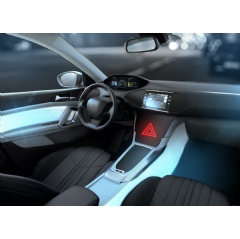
The Continental technology company looks back on a long tradition and, at the same time, opens up new opportunities for automotive interiors of the future: The success story of Acella, the company’s most famous surface brand, began as far back as 125 years ago. Today, the material is a prime example of innovative and long-lasting surface solutions for vehicle interiors.
“Acella is one of our most important brands,” says Dr. Dirk Leiß, head of the surfaces business unit at Continental. “The large and continuously growing product family is part of our core business.” Our innovations in mobility concepts of the future are evidence of this.
Environmentally friendly and trendsettingThe latest development, the translucent Acella Hylite concept, points the way to the future of the car: It enables special lighting effects through backlighting of the surfaces, which are particularly in demand in electric vehicles and in ideas related to autonomous driving. “Over the years, Acella has always remained young,” says Leiß. “We have succeeded in adapting the material to new conditions and market requirements over and over again. In the meantime, Acella stands for our largest product family and offers the right solution for every use.”
The question of sustainability is also increasingly more important. For example, the latest products have been developed sustainably from the outset. The material is a leader in low-odor and low-emission artificial leathers. It can now be produced solvent-free, using only water-based lacquers, and bio-based raw materials and recycled plastic can be used for the textile backs. Acella Light is used in modern lightweight design concepts, helping to reduce fuel consumption and therefore CO2 emissions.
Today, Acella continues to be the material of choice for car interior trims. “Its durability, monetary value and numerous design possibilities have made it so,” says Christian Nöll, who is responsible for the automotive business, summing up some of its most important product advantages. Supplied in rolls, Acella fully exploits its cost advantages over genuine leather, not just in terms of sourcing, but also in terms of the manufacturing process for our customers. Machine production also allows for a uniformly high surface quality, which cannot be guaranteed with genuine leather. Acella is also excellent for hygiene. The surface is resistant to soiling and easy to clean. “In terms of uses for seating in particular, the material has a clear advantage over leather and textile upholstery,” stresses Nöll.
Acella can be customized with the appropriate features for its respective uses and is produced in high quality on a global scale. Drivers and passengers benefit from the high level of comfort, high-quality designs and the durability of the material. The especially kink- and temperature-resistant Acella Protect is the most resistant material of the brand to date. It is used primarily in high-stress areas, for example in commercial vehicles and in agricultural and construction machinery.
How it all beganOn May 30, 1895, the company later known as Benecke-Kaliko AG, now part of Continental, registered its newly developed Nitro artificial leather brand Acella as a trademark at the Imperial Patent Office. On September 30, it was entered in the register of trademarks. With higher resistance to low temperatures and to aging – properties that still make Acella outstanding – it distinguished itself from the previously successful oilcloth and leather cloth with linseed oil varnish.
The company sold numerous products under the Acella brand name for almost three decades, mainly for domestic use. The “leather cloth” was the top seller in the early 1920s. It was used almost universally, but above all as furniture upholstery and for accessories in road vehicles and railway cars.
In the mid-1920s, the path from the oilcloth factory to the modern synthetics processing plant was led by a growing demand for artificial leather from the thriving automotive industry.
After WWII, the development and marketing of new PVC-based products under the well-known Acella brand resulted in it growing into the largest synthetics processing company in Europe. The skillful use of Acella’s properties enabled rapid growth. In the mid-1960s, the product range was expanded to include floor coverings for vehicles.
In the following years, new products were constantly being developed and other uses were found, mainly in the vehicle sector. But Acella also worked well in other areas. There was hardly a cinema that didn’t have Acella wall coverings.
The 1970s saw an abrupt increase in demand for Acella for vehicle interiors. At that time, in Hanover, experts in surfacing developed a technology that made it possible to give the synthetic material a realistic leather grain. Leiß: “With that, Acella finally became a fixed feature on the market, which today is hard to imagine without.”
tinyurlis.gdu.nuclck.ruulvis.netshrtco.de
مقالات مشابه
- مواد شیمیایی یک بسیار روشن تکنیک که برای همه کار میکند
- شرکت طراحی داخلی و دکوراسیون داخلی دکوطرح
- خشونت معافیت جدید در صربستان تظاهرات
- پایان دادن به حیوانات آزمایش: در پشت صحنه در تحقیقات ما hub
- ایتالیا از اروپا بازگشت. آن را نه متقابل.
- تعریف لامل میکروسکوپ
- شرکت صادرات و واردات کالاهای مختلف از جمله کاشی و سرامیک و ارائه دهنده خدمات ترانزیت و بارگیری دریایی و ریلی و ترخیص کالا برای کشورهای مختلف از جمله روسیه و کشورهای حوزه cis و سایر نقاط جهان - بازرگانی علی قانعی
- ساده ترین راه برای یادگیری زبان اسپانیایی به عنوان زبان اسپانیایی درس بوم در همکاری اسپانیایی پلت فرم پس از سهولت Covid-19 محدودیت
- سایت فروش کربن فعال | تجهیز یار
- چرا بیشتر مردم صحبت کردن در مورد 'افسانه'?